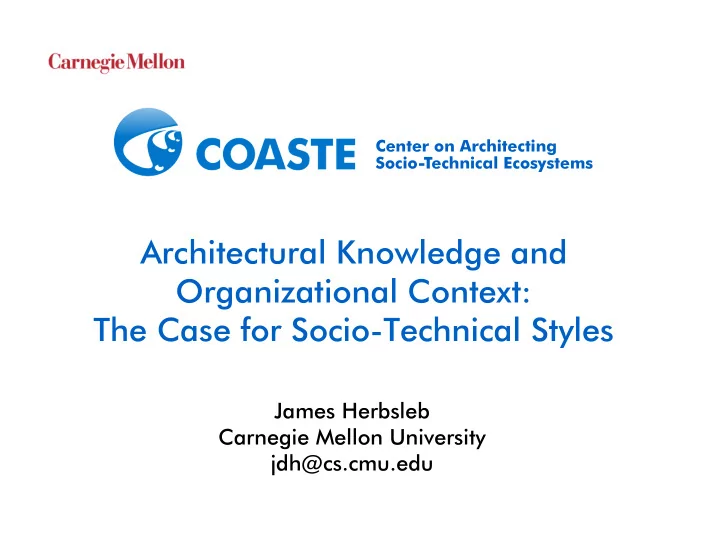

Center on Architecting Socio-Technical Ecosystems Architectural Knowledge and Organizational Context: The Case for Socio-Technical Styles James Herbsleb Carnegie Mellon University jdh@cs.cmu.edu
Photolithographic Alignment • Small architectural changes have often killed successful firms • Architecture gets embedded into organization – Communication paths – Cognitive filters – Problem-solving strategies Henderson, R.M. & Clark, K.B. (1990). Architectural Innovation: The Reconfiguration of Existing Product Technologies and the Failure of Established Firms. Administrative Science Quarterly , 35 (1), pp. 9-30.
Architectural Decisions • Influence technical characteristics of product • Also constrain design of organization • Conway’s Law – “Any organization that designs a system will inevitably produce a design whose structure is a copy of the organization's communication structure.” Conway, M.E. How do committees invent? Datamation , 14, 5 (1968), 28-31
Conway’s Law Is Static • Assumes architectural decisions all made up front, not changed • Assumes requirements won’t change – Requirements Δ architecture Δ • Assumes simple, static organizational structure – Ignores network structure • Assumes implementation will conform to architectural specification
Varieties of Change • Key elements – Interfaces (uncertainty, complexity) – Allocation of functionality – Bending the rules • How change propagates – Informing vs. negotiating – Interests at stake: degrees of “heat” • Ability to accommodate change varies dramatically – Coordination capability • How to bring architectures and organizations into alignment?
An Approach . . . • See successful patterns that recur, e.g., – Architectural styles – Design patterns – Problem frames • A way of capturing knowledge for reuse • Can we expand such ideas from technical to socio-technical?
Architectural Style: Pipe and Filter • Pipe-and-filter commitments, e.g., – Filter performs local transformation – Filters are independent – Filters do not know identity of up- or down-stream filters • Organizational commitments to handle change – Internal filter changes – local, no coordination (optimistically) – Interface changes – regional, just between producer/ consumer groups – Changes affecting global attributes – project-wide
Architectural Style: Layers • Layered systems commitments, e.g., – Each layer provides service to layer above – Each layer acts as a client to layer below – Components implement virtual machine • Organizational commitments to handle change – Internal layer changes – local – Interface changes – local if service remains backward compatible, or client does not need new services – Other Interface changes – regional, only between two layers – Changes affecting global attributes – central, or project- wide
Socio-Technical Style • Technical architectural style matched with organizational arrangements with the capacity to handle the kinds of coordination work the style requires.
Coordination Capacity • People factors • Organizational factors • Language skills • Divergent incentives • Culture • Divergent strategies • Expertise & TMS • Unclear goals • History of collaboration • Divergent tools, practices, processes • Organizational stability • Communication infrastructure
Coordination Capacity • Project factors • Number of sites • Time zones • Disciplinary or professional boundaries • People have multiple teams • Leadership style
A Few Examples . . . • Extracted from developers and architects at multinational engineering firm • Idealized • Echoes of product line engineering • Not necessarily seen multiple times • Have been integrated as a module in corporate training program for software architects This work was done in collaboration with Marcelo Cataldo and Sangeeth Nambiar .
Component Forking
Component Forking Forked component maintained locally Most components maintained centrally
Component Forking Gain: no need to coordinate across variants Loss: duplicated effort, difficulty in maintenance, impact of changing other components difficult to anticipate
Partitioned Component
Partitioned Variant part maintained locally Component Common part maintained Most components centrally maintained centrally
Partitioned Component Gain: no need to coordinate across variant parts Loss: duplicated effort, difficulty in maintenance, impact of changing other components difficult to anticipate
Component Slicing
Component Slicing Variant selected locally (configuration) All components maintained centrally
Component Slicing Gain: simplifies coordination around integrating and testing variants Loss: must communicate requirements for variants to central team
Centralized Runtime Dependencies
Centralized Runtime Dependencies Runtime functionality with complex interdependencies brought together in single component Maintained by team with global view, e.g., of error recovery
Centralized Runtime Dependencies Gain: Easier to correctly meet global requirements, e.g., complex error handling Loss: More difficult to evolve individual components with new or different error conditions, messages
Monolithic Layer-Spanning Components
Monolithic Layer-Spanning Components Most functionality is implemented in layers Exception granted for functionality with highly complex interactions across layers, e.g., sensors actuators, and computation for automatic parking
Monolithic Layer-Spanning Components Gain: ability to coordinate work within component B; use co-located team Loss: potentially very difficult integration with other components, unexpected interactions
An Observation • Centralized versus decentralized decision-making – Centralized can globally optimize decisions in stable environments – Centralized is bottleneck in highly dynamic environments – Centralized is slower, longer and larger information flows – Decentralized may be better for solving immediate problem, may cause future problems • Fundamental approach: solve the hardest problems by assigning all the closely-related work to a single, co-located team, manage the rest
Some Research Issues • How to capture the organizational part? • How to capture the dynamism that drives the style/pattern? • Dimensions of coordination capacity? – Communication bandwidth – Tendency to cooperate – Correct anticipation – Background knowledge
Recommend
More recommend